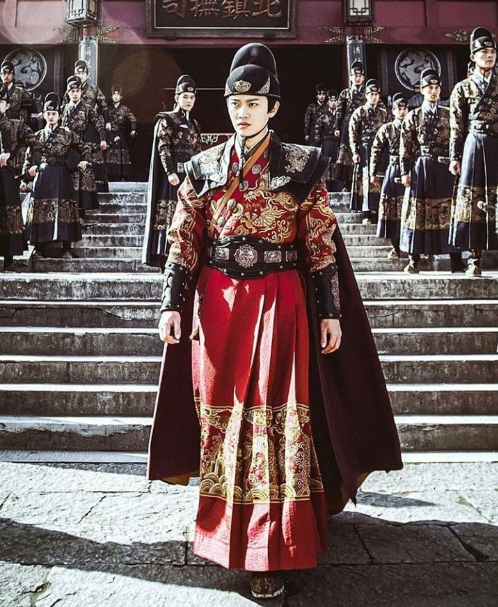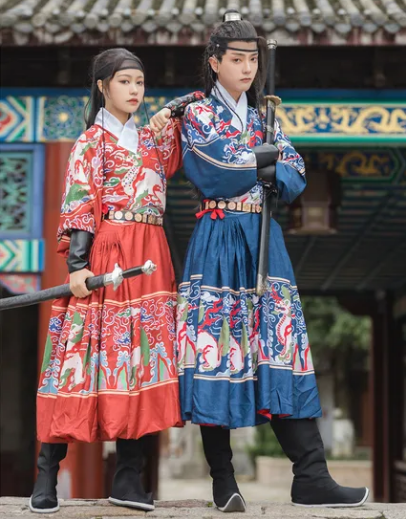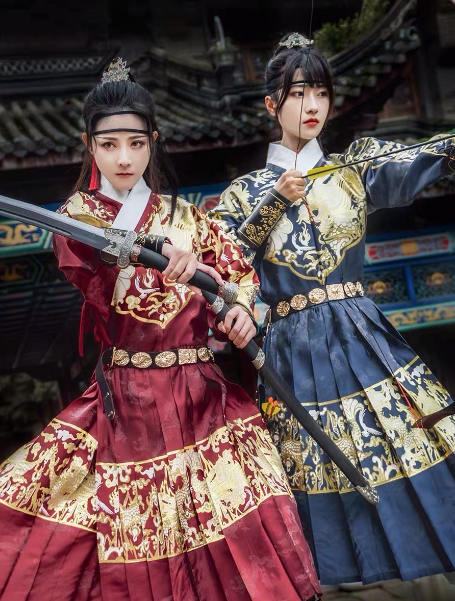Historical Origins of the Flying Fish Suit
At the dawn of the Ming Dynasty, the Flying Fish Suit emerged as a distinguished garment reserved for the elite. Master tailors dedicated their skills to crafting these garments, signifying the wearer’s proximity to the emperor and their elevated status within the imperial hierarchy.
Emergence and Design Evolution
Initially, the Flying Fish Suit boasted a straightforward design, mirroring the period’s modest aesthetic preferences. As the dynasty progressed, the design underwent a remarkable transformation. Tailors began incorporating more elaborate features, such as intricate embroideries and finer fabrics, to reflect the increasing sophistication of the Ming court.

Symbolism in Ming Dynasty Attire
Every stitch and hue on the Flying Fish Suit conveyed a deeper meaning. Gold threads woven into the fabric shone as a testament to the wearer’s wealth and influence. The imperial yellow of the emperor’s suit stood out boldly, while other officials donned colors that illustrated their rank with equal clarity. Additionally, the embroidered flying fish served as a metaphor for the wearer’s ability to navigate the imperial administration with grace and efficiency.
Artisans meticulously ensured that each Flying Fish Suit exemplified exceptional quality. They chose only the most durable and lustrous silks, understanding that the garment’s longevity and appearance were paramount. Consequently, the time invested in creating these suits varied, often taking months to perfect, and the cost mirrored the luxurious materials and painstaking labor invested.
Moreover, these suits transcended their role as mere clothing. They were emblems of authority and a visible marker of one’s place in the intricate web of Ming governance. Their value was immeasurable, not solely in terms of material and labor but as a symbol of imperial favor and a badge of prestige.
The Components of the Flying Fish Suit
The Flying Fish Suit, a vestment of distinction, comprised several parts, each serving to enhance the visual impact and significance of the attire. Every element, from the robe to the accessories, was a testament to the wearer’s esteemed position in Ming society.
Fabrics and Materials Used
Artisans selected fabrics for the Flying Fish Suit with utmost care, choosing silk for its sheen and resilience. Often, they would weave in threads of gold and silver to create patterns that caught the light, adding to the garment’s opulence. Such materials were costly, reflecting the suit’s exclusivity, with silk prices varying depending on its quality and origin.
Distinctive Features and Accessories
The most striking feature of the Flying Fish Suit was the eponymous flying fish emblem, embroidered prominently on the garment. This symbol was typically accompanied by other auspicious motifs, like dragons or clouds, each meticulously crafted to convey a message of power and divine favor.
Accessories complemented the suit, including hats with wing-like flaps and belts adorned with jade, both indicators of rank and prestige. These additions were not merely ornamental; they signified the official’s authority and were as much a part of the uniform as the robe itself.
Quality and craftsmanship were paramount. Tailors took considerable time, sometimes several months, to complete a suit, with the cost reflecting both the labor intensity and the premium materials used. Such garments were long-lasting, their quality ensuring they could endure years of wear while retaining their splendor.
The Flying Fish Suit’s materials and design intricacies made it much more than clothing. It was a wearable artifact of Ming Dynasty culture, embodying the era’s artistic achievements and the meticulousness of its social hierarchy.
Socio-Political Significance
The Flying Fish Suit transcended its role as mere clothing, assuming a profound socio-political significance within the context of the Ming Dynasty. It was not merely a matter of fashion but a symbol of authority, privilege, and adherence to a strict hierarchical system.
The Suit as a Status Symbol
- Rank and Status: Wearing a Flying Fish Suit signaled one’s elevated status within the Ming Dynasty’s bureaucratic structure. High-ranking officials and the emperor donned these garments, with colors and designs denoting their specific positions. For example, blue robes were reserved for civil officials, while military officials wore red.
- Imperial Favor: The Emperor bestowed the Flying Fish Suit as a mark of favor, symbolizing not only the recipient’s loyalty but also their competence. To receive such a garment was an honor, and it elevated one’s prestige both in the court and in society.
- Wealth and Luxury: The cost of the suit, including the precious materials and skilled labor required for its creation, placed it beyond the reach of most individuals. Owning and wearing a Flying Fish Suit demonstrated significant wealth and financial prowess.
- Social Distinction: The garment also marked a clear distinction between the elite and commoners. Those who wore it were considered part of the elite ruling class, while those excluded from its privilege occupied lower rungs of society.
Regulations and Restrictions on Wearing the Flying Fish Suit
- Imperial Decrees: The right to wear the Flying Fish Suit was subject to imperial decrees. Only those who received official permission from the emperor or high-ranking officials could don the attire.
- Strict Hierarchy: Regulations dictated the colors and designs of the Flying Fish Suits based on an individual’s rank and position. Violating these rules was seen as a breach of decorum and could result in severe consequences.
- Controlled Distribution: The production and distribution of the Flying Fish Suits were tightly controlled by the imperial court. This ensured that only those with the appropriate status and authority could possess and wear these prestigious garments.
- Maintenance of Order: These regulations served to maintain order within the Ming Dynasty’s social structure. They reinforced the authority of the emperor and the bureaucracy while preventing unauthorized individuals from impersonating high-ranking officials.
The socio-political significance of the Flying Fish Suit underscored its role as more than a mere article of clothing. It was a tangible expression of the Ming Dynasty’s governance, hierarchy, and the power structures that defined the era.

Manufacturing Techniques
The creation of the Flying Fish Suit involved a combination of intricate manufacturing techniques, encompassing traditional tailoring methods and exquisite embroidery and ornamentation.
Traditional Tailoring Methods
- Hand-Cutting and Sewing: Skilled tailors meticulously hand-cut and sewed the fabric for each Flying Fish Suit. Precision was paramount to ensure a perfect fit and an impeccable finish.
- Layering and Padding: The suit’s construction often involved multiple layers of fabric, providing durability and structure. Padded sections added dimension and elegance to the garment.
- Silk Lining: The interior of the Flying Fish Suit was typically lined with fine silk, enhancing comfort and luxury for the wearer. The choice of lining silk was crucial for its softness and breathability.
- Custom Fitting: Tailors paid close attention to the wearer’s body measurements, ensuring a tailored fit. This made each suit unique and tailored to the individual’s physique.
Embroidery and Ornamentation
- Intricate Embroidery: The flying fish emblem and other motifs were meticulously embroidered onto the fabric using silk threads. These intricate designs showcased the artisan’s skill and creativity.
- Gold and Silver Thread: To add opulence and luster to the designs, gold and silver threads were often incorporated. These precious metals elevated the aesthetic appeal of the suit but also increased its production cost.
- Precise Detailing: Artisans paid careful attention to even the smallest details in their embroidery work. This level of precision required time and skill, contributing to the overall cost of the garment.
- Symbolic Elements: Beyond aesthetics, the embroidery on the Flying Fish Suit conveyed deep symbolism. Dragons, phoenixes, and other auspicious symbols were included to bestow positive connotations upon the wearer.
The manufacturing process of the Flying Fish Suit was an art form in itself, blending traditional craftsmanship with meticulous attention to detail. While it produced garments of unparalleled beauty and cultural significance, it also came with a high cost, both in terms of time and materials, befitting the suit’s esteemed status within Ming Dynasty society.
The Flying Fish Suit in Cultural Practices
The Flying Fish Suit held a prominent place in Ming Dynasty culture, extending beyond its utilitarian purpose into various cultural practices, ceremonies, and artistic representations.
Ceremonial Functions and Rituals
- Imperial Ceremonies: The Flying Fish Suit was central to grand imperial ceremonies. Emperors wore these suits during important state occasions, such as coronations and official banquets. The presence of the emperor in such attire added solemnity and prestige to these events.
- Weddings and Celebrations: High-ranking officials often wore Flying Fish Suits at weddings and other significant celebrations. It symbolized the union of two families and the couple’s elevated status within society.
- Funerals: The suit also had a role in funerary rituals. Officials might be buried in their Flying Fish Suits as a sign of respect for their service and status in the afterlife.
- Gift Giving: Gifting a Flying Fish Suit was a gesture of goodwill and favor. Emperors and high-ranking officials would present these suits to demonstrate their appreciation or to secure alliances.
Representation in Arts and Literature
- Paintings and Portraits: The Flying Fish Suit featured prominently in Ming Dynasty paintings and portraits, depicting emperors and officials in their regal attire. These artworks preserved the visual splendor of the era.
- Literary References: Ming Dynasty literature often mentioned the Flying Fish Suit in descriptions of characters or settings. It served as a symbol of a character’s social status or was used to set the historical context.
- Dramatic Performances: In traditional Chinese theater, actors would wear costumes inspired by the Flying Fish Suit when portraying historical figures. This practice added authenticity and visual appeal to theatrical productions.
- Poetry and Verses: Poets frequently referenced the Flying Fish Suit in their verses, using it as a metaphor for power, prestige, and the transient nature of worldly possessions.
The Flying Fish Suit’s cultural significance extended its influence into various aspects of Ming Dynasty life. It became an integral part of ceremonies, rituals, and artistic expressions, reflecting the deep-rooted importance of this attire in the society of that era.
Legacy and Influence
The Flying Fish Suit’s legacy and influence extend well beyond the Ming Dynasty, leaving a lasting imprint on both historical preservation and contemporary fashion and pop culture.
Preservation of Flying Fish Suits in Modern Times
- Museum Exhibits: Several museums worldwide house well-preserved Flying Fish Suits, offering visitors a glimpse into the craftsmanship and opulence of the Ming Dynasty. Notable examples include the National Palace Museum in Taipei and the Palace Museum in Beijing.
- Cultural Revival: Efforts to preserve traditional Chinese clothing have led to a resurgence of interest in the Flying Fish Suit. Artisans and historians work together to recreate these garments, using traditional techniques and materials, ensuring that the knowledge and skills associated with their creation are not lost.
- Academic Research: Scholars and researchers continue to study Flying Fish Suits, exploring their historical significance, materials, and manufacturing techniques. This research contributes to a deeper understanding of Ming Dynasty culture and society.
- Costume Festivals: The Flying Fish Suit occasionally makes appearances at cultural festivals and historical reenactments, allowing modern audiences to appreciate the attire’s splendor and significance.
Influence on Contemporary Fashion and Pop Culture
- Fashion Design: Elements of the Flying Fish Suit, such as intricate embroidery and rich colors, have inspired modern fashion designers. Runway collections and haute couture often feature motifs reminiscent of this iconic attire.
- Cultural Fusion: The fusion of traditional Chinese elements, including designs inspired by the Flying Fish Suit, has become a trend in global fashion. This fusion highlights the cross-cultural appeal and adaptability of these designs.
- Film and Television: The Flying Fish Suit has appeared in historical dramas and films, both in China and internationally. Its opulent appearance and symbolism add authenticity and visual appeal to period productions.
- Pop Icons: Celebrities and pop culture icons occasionally incorporate Flying Fish Suit-inspired elements into their wardrobes or performances, creating a bridge between traditional Chinese attire and contemporary style.
The Flying Fish Suit’s legacy endures through the preservation of historical artifacts and its influence on modern fashion and popular culture. Its timeless appeal and rich history continue to captivate and inspire people around the world, highlighting the enduring significance of this Ming Dynasty masterpiece.
